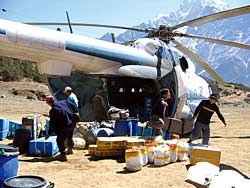 The international media has had a great time calling it the 'toilet paper trail', or 'the world's highest garbage dump'.
The international media has had a great time calling it the 'toilet paper trail', or 'the world's highest garbage dump'. What a relief it is, therefore, to see that not only is there very little garbage on the Khumbu trail, but that there is an active movement to reduce trash along one of the world's most popular trekking routes.
"There is no pollution in the Khumbu region and the trails leading up to Base Camp are clean and trash-free," says second-time visitor Anuar Suun, a professor from a Malaysian university who is here to lead the Malaysian Youth Everest Expedition to Mt Everest for the second time.
"It is true that in the 1980s, things got a little out of hand," admits Dorje Lama Sherpa of the Sagarmatha Pollution Control Committee (SPCC). "But we now realise that our livelihood depends on keeping the trails clean."
Established in 1994 by local Sherpas, the SPCC was set up jointly by the Ministry of Tourism and Civil Aviation in Kathmandu and the Worldwide Fund for Nature (WWF). The idea was to set up garbage disposal sites along the trail and at regular camping sites and establish an efficient system of recycling or removing waste. Between 1994 to 2003, the SPCC has already removed more than 2,000 tonnes of garbage from the Sagarmatha National Park.
All along the trail, there are rubbish bins with concrete foundations (to prevent leakage) and bamboo lattice cylinders to contain the trash. The garbage collected is deposited at incinerators in Tengboche, Namche and Lukla. Last year was the 50th anniversary of the first ascent of Mt Everest and saw record numbers of trekkers and mountaineers in Khumbu who dumped 325,000kg of trash. Of this, 240,000 was incinerated, and the rest was made up of metal, bottles and cans that the SPCC ferried to Kathmandu for reuse or recycling.
"Our aim is increase community participation in environmental conservation and community awareness in garbage management at the local level," explains Biso Bajracharya of the SPCC.
With trekking traffic picking up this season, it looks like the numbers may hit an all-time high, but the SPCC seems geared up to meet the challenge. Each mountaineering expedition has to register their material at the SPCC office in Syangboche airfield before leaving for base camp and check back on return. They are charged a deposit of $4,000 for Mt Everest, $3,000 for mountains 8,000m and higher, and $2,000 for mountains above 7,000m.
 A mountain inspection officer monitors the garbage situation of the expeditions at base camps, on the lookout for any unauthorised dumping along the glaciers and crevasses. If anyone is caught, deposits are confiscated. Expeditions which follow the rules are given Garbage Clearance certificates, which have actually become a popular souvenir and are framed by proud mountaineers when they get home.
A mountain inspection officer monitors the garbage situation of the expeditions at base camps, on the lookout for any unauthorised dumping along the glaciers and crevasses. If anyone is caught, deposits are confiscated. Expeditions which follow the rules are given Garbage Clearance certificates, which have actually become a popular souvenir and are framed by proud mountaineers when they get home. Inspectors are not just on the lookout for improper garbage disposal, they also monitor fuel and firewood use. High altitude forests take a long time to regenerate and the SPCC helps the National Park monitor the transport of firewood and the use of juniper bushes for campfires, especially by porters. Kerosene depots have been set up along the trail, and LPG gas has been made available to high-energy consuming locals, trekking lodges and even some larger expeditions.
The SPCC's main source of income is an innovative revenue-generating idea: rebuilding the Khumbu Icefall route on Mt Everest at the beginning of every season and maintaining it. Expeditions then pay a fixed amount of toll to use the route while they go up and down from the summit.
The Khumbu Icefall is a constantly shifting jumble of seracs and ice the size of apartment blocks. Negotiating the icefall takes time and saps the energy of expeditions, so they let the SPCC do it for them.
In the spring of 2003 , there were 26 expeditions on Mt Everest and Lhotse and the SPCC charged $2,875 from each expedition for the use of its route, which consisted of fixed-rope and ladder bridge sections. In the autumn season last year there were only six expeditions and they were charged $6,000 for the route. This spring season, there are some 15 expeditions and the rate has been fixed at $2,500.
Now, the SPCC is getting even more ambitious and wants to monitor garbage at Advanced Base Camp and Camps I and II in the Western Cwm to check if expeditions take down everything they brought up. One thing the SPCC wants to work on right away is a public toilet at Base Camp.


